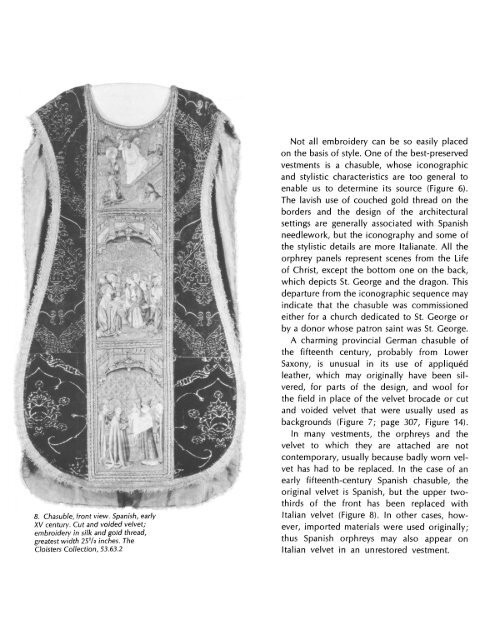The Metropolitan Museum of Art Bulletin, v. 29, no. 7 (March, 1971)
The Metropolitan Museum of Art Bulletin, v. 29, no. 7 (March, 1971)
The Metropolitan Museum of Art Bulletin, v. 29, no. 7 (March, 1971)
You also want an ePaper? Increase the reach of your titles
YUMPU automatically turns print PDFs into web optimized ePapers that Google loves.
8. Chasuble, front view. Spanish, early<br />
XV century. Cut and voided velvet;<br />
embroidery in silk and gold thread,<br />
greatest width 251/2 inches. <strong>The</strong><br />
Cloisters Collection, 53.63.2<br />
Not all embroidery can be so easily placed<br />
on the basis <strong>of</strong> style. One <strong>of</strong> the best-preserved<br />
vestments is a chasuble, whose ico<strong>no</strong>graphic<br />
and stylistic characteristics are too general to<br />
enable us to determine its source (Figure 6).<br />
<strong>The</strong> lavish use <strong>of</strong> couched gold thread on the<br />
borders and the design <strong>of</strong> the architectural<br />
settings are generally associated with Spanish<br />
needlework, but the ico<strong>no</strong>graphy and some <strong>of</strong><br />
the stylistic details are more Italianate. All the<br />
orphrey panels represent scenes from the Life<br />
<strong>of</strong> Christ, except the bottom one on the back,<br />
which depicts St. George and the dragon. This<br />
departure from the ico<strong>no</strong>graphic sequence may<br />
indicate that the chasuble was commissioned<br />
either for a church dedicated to St. George or<br />
by a do<strong>no</strong>r whose patron saint was St. George.<br />
A charming provincial German chasuble <strong>of</strong><br />
the fifteenth century, probably from Lower<br />
Saxony, is unusual in its use <strong>of</strong> appliqued<br />
leather, which may originally have been silvered,<br />
for parts <strong>of</strong> the design, and wool for<br />
the field in place <strong>of</strong> the velvet brocade or cut<br />
and voided velvet that were usually used as<br />
backgrounds (Figure 7; page 307, Figure 14).<br />
In many vestments, the orphreys and the<br />
velvet to which they are attached are <strong>no</strong>t<br />
contemporary, usually because badly worn velvet<br />
has had to be replaced. In the case <strong>of</strong> an<br />
early fifteenth-century Spanish chasuble, the<br />
original velvet is Spanish, but the upper twothirds<br />
<strong>of</strong> the front has been replaced with<br />
Italian velvet (Figure 8). In other cases, however,<br />
imported materials were used originally;<br />
thus Spanish orphreys may also appear on<br />
Italian velvet in an unrestored vestment.

















